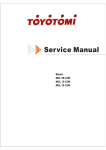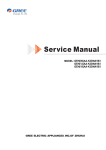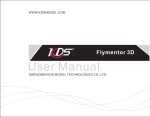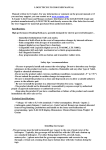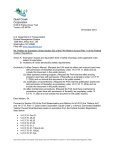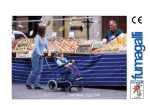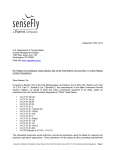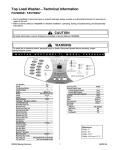Download FLIGHTTEST - Audacity Models
Transcript
FLIGHTTEST “ “ BY MIKE McGEE > PHOTOS BY MIKE McGEE & JIM SPEARS The Tiger 50 is all about delivering a HIGH-QUALITY HELI at a cost that’s hard to beat.… AUDACITY MODELS TIGER 50 Low cost–audacious performance! IN THE HELICOPTER WORLD, the .50-class heli is one of the best values around, and when compared with a larger .60/.90 helicopter, the reasons quickly become obvious. This smaller heli is easy to afford and less expensive to repair, it’s very stable, and its agility is excellent because it weighs less. In addition, most .50class engines are almost as powerful as the .60s, and this gives them an outstanding power-to-weight ratio. AUGUST 2005 51 FLIGHTTEST “ “ BY MIKE McGEE > PHOTOS BY MIKE McGEE & JIM SPEARS The Tiger 50 is all about delivering a HIGH-QUALITY HELI at a cost that’s hard to beat.… AUDACITY MODELS TIGER 50 Low cost–audacious performance! IN THE HELICOPTER WORLD, the .50-class heli is one of the best values around, and when compared with a larger .60/.90 helicopter, the reasons quickly become obvious. This smaller heli is easy to afford and less expensive to repair, it’s very stable, and its agility is excellent because it weighs less. In addition, most .50class engines are almost as powerful as the .60s, and this gives them an outstanding power-to-weight ratio. AUGUST 2005 51 >>> AUDACITY MODELS TIGER 50 SPECIFICATIONS MODEL: Tiger 50 MANUFACTURER: Audacity Models DISTRIBUTOR: Genesis Hobby Distributors MAIN ROTOR DIAMETER: 52.5 in. (1,335mm) LENGTH: 42.5 in. (1,232mm) WEIGHT: 7 lb. 5 oz. RADIO REQ’D: 5-channel heli w/120degree CCPM PRICE: $285 kit; $299 ARF >>> COMMENTS At last—a heli that’s well suited to both beginners and experts. Low-cost and easy to build and set up, the Tiger 50 is the perfect heli for learning new tricks. >>> Four guides support the tail-rotor pushrod along the length of the tail boom. Note the bead that the pushrod rides in and how the guide firmly captures it. HIGHLIGHTS The latest heli in the .50-size market is the Tiger 50 manufactured by Audacity Models. This excellent, low-cost model is certain to give the “other guys” a run for their money. And don’t be fooled by its price tag ($285 kit; $299 ARF; the Tiger 50 delivers heart-pounding 3D performance right out of the box by using the simplicity of 120-degree cyclic/collective pitch mixing (CCPM) and a reliable belt-driven tail rotor. As I found out, the Tiger 50 is a high-quality heli that’s easy to build and fun to fly at a cost that’s hard to beat. Read on to learn more. KIT OVERVIEW The Tiger 50 comes in two versions: almostready-to-fly (ARF) and as a kit (the subject of this review). To apply the term “kit” to the Tiger 50 is somewhat misleading because all its major assemblies (with the exception of the engine/clutch, chassis and tail rotor) are factory-built; the pushrods have even been assembled to their correct lengths for a symmetrical 3D setup. This feature alone demonstrates that the Tiger 50 is a cut above the rest. And it doesn’t stop there, as it has some features that are usually found only on high-end helicopters. The main rotor head is fully assembled and uses two radial bearings. It also includes thrust bearings for the demanding rigors of 3D flight. The seesaw carrier is fully ball-raced for smooth operation, and the kit includes a set of finished 600mm wooden blades. I know that a lot of experienced heli pilots prefer fiberglass or carbon blades and won’t use the wooden ones, but they are a welcome inclusion for beginners. Also for beginners, the washoutmixing arms can be tuned to soften the con- >Excellent manual >Easy to build >Low cost >Outstanding flight characteristics The sturdy rotor head is well designed for responsive and smooth operation. trol response. The aluminum tail boom is well supported by two braces that are attached to the bottom of the chassis for maximum stiffness; this helps to make the tail rotor responsive and precise. The tail rotor has more than 60 degrees of pitch range, and to keep it under control, the pitch slider is bearing-supported and guided by a dual-pin bellcrank assembly. Another nice feature is that each tail-rotor blade grip is equipped with dual ball bearings. The fuel tank, mounted on vibration-absorbing grommets, is a massive 14 ounces for long flights, so you can really wring this wildcat out. The 58-page instruction manual is a highlight that deserves special mention: it’s very well illustrated and lists the items needed to complete the heli and the required assembly tools. Further, almost every assembly stage contains a “Pro tip.” It also clearly explains the mechanical and electronic setups of 120degree CCPM and how they interact with each other. To illustrates this, many graphs show examples of throttle and pitch curves for hovering and 3D aerobatics. If you’ve never used CCPM, this is an excellent guide. The manual also shows the precise position of the servo arms, where the balls need to be on the servo arms and the lengths of the pushrods. As you can see, Audacity Models has spent considerable time and energy to make the Tiger 50 setup as easy as possible. ASSEMBLY >Chassis The Tiger 50 builds quickly, so I’ll only highlight items and not recite a blowby-blow of “screw this part to that part.” Most of the assembly centers on the chassis, which is molded of tough, reinforced plastic that will survive many crashes. The first items are the clutch bell and the tail drive; both are factory assembled, so we’re already ahead of the game! Attach the elevator link to the swashplate arm with a steel pin that’s tapped into place. Make sure that the mold marks on the link face toward the rear of the heli, as the molded-in ball link is a one-way link. Fuel-tank assembly is straightforward; check the tank for any tiny scraps of plastic in it before you seal it. Instead of having to fiddle with separate nuts to secure the servos, one-piece servo boss plates are used. They’re simply pushed into place wherever a servo is mounted and make servo installation a snap. To assemble the chassis, add the subassemblies and screw the frames together. I really like that the frames are held together with socket-head bolts and locknuts instead of sheet-metal screws; no stripped mounting holes here! When you mate the frames, be sure to use the main shaft to perfectly align its bearings. Add the radio and gyro platform, the canopy mounts and the landing gear to complete the basic chassis build. When you add the main shaft and the main gear, make sure they’re oriented correctly, and be sure to use the proper shoulder bolt on the gear. A groove is machined into the shaft for the mast stopper’s setscrews. A lot of helis don’t have this welcome little detail. The most difficult assembly task was adding the cooling fan and clutch to the engine, as the fan hub uses a straight hole instead of a tapered collet and both must be dial-indicated for a smooth-running heli. When you add the engine to the chassis, insert the start shaft first, or you’ll have to remove the engine to add it. >Main rotor and tail rotor. The rotor head, swashplate and washout unit are factoryassembled, so all you need to do is add them to the heli. Then install and center the flybar and its paddles, and snap the pushrods into place. You have the option of installing lead weight in the paddles for a softer con- FROM TAME CAT TO WILDCAT IN STOCK FORM, THE TIGER 50 is a real pussycat that can satisfy pilots of This right-side view of the chassis shows a neat and orderly layout. Note the clips for the servos leads. 52 MODEL AIRPLANE NEWS The pitch slider has two bearings for reliable operation, and it’s guided by forked bellcrank that uses dual pins. different skill levels. To really unleash this cat, however, Audacity Models offers a range of inexpensive parts that increase the heli’s prowess. First is the 3D seesaw (flybar carrier). This part is included with the kit, and it has an extra set of holes in it. This has the advantage of offering both the 1:1 and 0.7:1 Bell-Hiller mixing ratios (inner holes) that are used for 3D flight. Audacity also offers harder 3D dampers that allow stiffer damping, and that, in turn, permits more aggressive flight. To get more leverage from the swashplate, a set of 3D ball extensions is offered and takes only a couple of minutes to add to the swashplate. Top this off with a 3D flybar and paddles, and you’ll have a heli that allows you a customized control response better suited for extreme 3D maneuvers. Just remember, though, that with increased control throw comes the possibility of binding, so be sure to check for any interference at the extremes of throw travel. FEBRUARY 2002 13 >>> AUDACITY MODELS TIGER 50 SPECIFICATIONS MODEL: Tiger 50 MANUFACTURER: Audacity Models DISTRIBUTOR: Genesis Hobby Distributors MAIN ROTOR DIAMETER: 52.5 in. (1,335mm) LENGTH: 42.5 in. (1,232mm) WEIGHT: 7 lb. 5 oz. RADIO REQ’D: 5-channel heli w/120degree CCPM PRICE: $285 kit; $299 ARF >>> COMMENTS At last—a heli that’s well suited to both beginners and experts. Low-cost and easy to build and set up, the Tiger 50 is the perfect heli for learning new tricks. >>> Four guides support the tail-rotor pushrod along the length of the tail boom. Note the bead that the pushrod rides in and how the guide firmly captures it. HIGHLIGHTS The latest heli in the .50-size market is the Tiger 50 manufactured by Audacity Models. This excellent, low-cost model is certain to give the “other guys” a run for their money. And don’t be fooled by its price tag ($285 kit; $299 ARF; the Tiger 50 delivers heart-pounding 3D performance right out of the box by using the simplicity of 120-degree cyclic/collective pitch mixing (CCPM) and a reliable belt-driven tail rotor. As I found out, the Tiger 50 is a high-quality heli that’s easy to build and fun to fly at a cost that’s hard to beat. Read on to learn more. KIT OVERVIEW The Tiger 50 comes in two versions: almostready-to-fly (ARF) and as a kit (the subject of this review). To apply the term “kit” to the Tiger 50 is somewhat misleading because all its major assemblies (with the exception of the engine/clutch, chassis and tail rotor) are factory-built; the pushrods have even been assembled to their correct lengths for a symmetrical 3D setup. This feature alone demonstrates that the Tiger 50 is a cut above the rest. And it doesn’t stop there, as it has some features that are usually found only on high-end helicopters. The main rotor head is fully assembled and uses two radial bearings. It also includes thrust bearings for the demanding rigors of 3D flight. The seesaw carrier is fully ball-raced for smooth operation, and the kit includes a set of finished 600mm wooden blades. I know that a lot of experienced heli pilots prefer fiberglass or carbon blades and won’t use the wooden ones, but they are a welcome inclusion for beginners. Also for beginners, the washoutmixing arms can be tuned to soften the con- >Excellent manual >Easy to build >Low cost >Outstanding flight characteristics The sturdy rotor head is well designed for responsive and smooth operation. trol response. The aluminum tail boom is well supported by two braces that are attached to the bottom of the chassis for maximum stiffness; this helps to make the tail rotor responsive and precise. The tail rotor has more than 60 degrees of pitch range, and to keep it under control, the pitch slider is bearing-supported and guided by a dual-pin bellcrank assembly. Another nice feature is that each tail-rotor blade grip is equipped with dual ball bearings. The fuel tank, mounted on vibration-absorbing grommets, is a massive 14 ounces for long flights, so you can really wring this wildcat out. The 58-page instruction manual is a highlight that deserves special mention: it’s very well illustrated and lists the items needed to complete the heli and the required assembly tools. Further, almost every assembly stage contains a “Pro tip.” It also clearly explains the mechanical and electronic setups of 120degree CCPM and how they interact with each other. To illustrates this, many graphs show examples of throttle and pitch curves for hovering and 3D aerobatics. If you’ve never used CCPM, this is an excellent guide. The manual also shows the precise position of the servo arms, where the balls need to be on the servo arms and the lengths of the pushrods. As you can see, Audacity Models has spent considerable time and energy to make the Tiger 50 setup as easy as possible. ASSEMBLY >Chassis The Tiger 50 builds quickly, so I’ll only highlight items and not recite a blowby-blow of “screw this part to that part.” Most of the assembly centers on the chassis, which is molded of tough, reinforced plastic that will survive many crashes. The first items are the clutch bell and the tail drive; both are factory assembled, so we’re already ahead of the game! Attach the elevator link to the swashplate arm with a steel pin that’s tapped into place. Make sure that the mold marks on the link face toward the rear of the heli, as the molded-in ball link is a one-way link. Fuel-tank assembly is straightforward; check the tank for any tiny scraps of plastic in it before you seal it. Instead of having to fiddle with separate nuts to secure the servos, one-piece servo boss plates are used. They’re simply pushed into place wherever a servo is mounted and make servo installation a snap. To assemble the chassis, add the subassemblies and screw the frames together. I really like that the frames are held together with socket-head bolts and locknuts instead of sheet-metal screws; no stripped mounting holes here! When you mate the frames, be sure to use the main shaft to perfectly align its bearings. Add the radio and gyro platform, the canopy mounts and the landing gear to complete the basic chassis build. When you add the main shaft and the main gear, make sure they’re oriented correctly, and be sure to use the proper shoulder bolt on the gear. A groove is machined into the shaft for the mast stopper’s setscrews. A lot of helis don’t have this welcome little detail. The most difficult assembly task was adding the cooling fan and clutch to the engine, as the fan hub uses a straight hole instead of a tapered collet and both must be dial-indicated for a smooth-running heli. When you add the engine to the chassis, insert the start shaft first, or you’ll have to remove the engine to add it. >Main rotor and tail rotor. The rotor head, swashplate and washout unit are factoryassembled, so all you need to do is add them to the heli. Then install and center the flybar and its paddles, and snap the pushrods into place. You have the option of installing lead weight in the paddles for a softer con- FROM TAME CAT TO WILDCAT IN STOCK FORM, THE TIGER 50 is a real pussycat that can satisfy pilots of This right-side view of the chassis shows a neat and orderly layout. Note the clips for the servos leads. 52 MODEL AIRPLANE NEWS The pitch slider has two bearings for reliable operation, and it’s guided by forked bellcrank that uses dual pins. different skill levels. To really unleash this cat, however, Audacity Models offers a range of inexpensive parts that increase the heli’s prowess. First is the 3D seesaw (flybar carrier). This part is included with the kit, and it has an extra set of holes in it. This has the advantage of offering both the 1:1 and 0.7:1 Bell-Hiller mixing ratios (inner holes) that are used for 3D flight. Audacity also offers harder 3D dampers that allow stiffer damping, and that, in turn, permits more aggressive flight. To get more leverage from the swashplate, a set of 3D ball extensions is offered and takes only a couple of minutes to add to the swashplate. Top this off with a 3D flybar and paddles, and you’ll have a heli that allows you a customized control response better suited for extreme 3D maneuvers. Just remember, though, that with increased control throw comes the possibility of binding, so be sure to check for any interference at the extremes of throw travel. FEBRUARY 2002 13 >>> IN THE AIR With everything checked and double-checked, it was time to get this cat airborne. All flying was done with the stock wooden blades, and we used Morgan 30% heli fuel. For hovering and sport aerobatics, we used the stock paddles with the lead weights installed, while the more advanced maneuvers were performed with the stock setup and we then added the 3D parts for a direct comparison. PITCH CURVES (IN DEGREES) Low stick Mid stick Normal -3 +5 Idle up 1 -5 +4 Idle up 2 -10 0 Throttle hold -5 +5 High stick +10 +10 +10 +12 HOVER STABILITY The first hover was a very pleasant surprise, as almost no trim changes were needed. The head speed at around 1,400 to 1,500rpm felt very good, and the blade tracking was perfect. Not bad for factory-adjusted links. In wind gusts, holding a steady hover was easy because the Tiger is very solid. The cyclic controls are well balanced, and the tail rotor has plenty of authority to hold the Tiger firmly in a strong crosswind. SPORT AEROBATICS The stock setup of head damping and weighted paddles provides a somewhat soft feel, but this helps the Tiger attain a stable hover and feel. Pushing the Tiger into forward flight showed that it tracks superbly. trol response, which is great for beginners. The ball links are designed to fit one way only and are supposed to have the letters “HD” molded on their fronts, but for some reason, the “HD” is missing. If you look closely at the link, however, you’ll see a ring that’s molded around the ball hole; this is >> GEAR USED RADIO: JR 10X transmitter & JR 649 receiver, 3 JR 8231 digital servos (cyclic & collective), 1 JR 2700G (rudder), 1 JR 4001 servo (throttle), JR 500T Ring gyro ENGINE: O.S. .50SX-H Hyper MUFFLER: K&S 50 Competition FUEL: Morgan 30% heli 54 MODEL AIRPLANE NEWS Starting with some stall turns, the Tiger’s vertical climb is impressive and seems to last quite long. Moving on to loops, the Tiger performs them at will and at any diameter you wish. Rolls were equally easy to do, but they do require a little fore/aft correction through the maneuver to make them axial. Mild 3D maneuvers such as flips and tumbles revealed that the Tiger handles them well, but it tends to slow down as it rotates through them; this was mainly due to the stock damping and weighted paddles. 3D AEROBATICS I added Audacity’s 3D upgrade parts and cranked up the head speed to around 1,700rpm. I would have liked to use a higher speed of 1,800 to 1,850rpm, but I didn’t want to over-stress the stock wooden blades. With the higher rotor speed, the Tiger still ran smoothly and was a lot more responsive. Punching the throttle, the model climbed aggressively without fanfare. The collective response was splendid, and as we put it through its paces, the cyclic response was tight and quick. Climbing to altitude, consecutive flips and tumbles were a lot more rapid, and it was easy to time cyclic inputs. Other maneuvers such as point rolls and flips were positive and sharp. It was easy to quickly master the Tiger. I like to finish my flights with some autorotations, and the Tiger is easygoing in this flight mode. With the optional Limited Slip Drive installed, pirouetting and backward autos are possible. Be aware, though, that in calm conditions the stock blades will run out of inertia and not leave much room for errors. The Tiger 50 is an impressive model that’s capable of a lot of performance. I’m having a ball with mine! the back side of the link that faces the servo arm. Assembling the tail rotor and tail boom is quick and easy; just follow the instructions. Be sure that you orient the drive belt correctly before it is tensioned, or the tail rotor will turn backward. >Radio installation and setup. Like the rest of the heli, radio installation is painless. As you install the servos, you’ll appreciate the servo bosses you installed earlier. Route the servo leads to the front of the heli, and make sure that they don’t contact any moving parts. Molded-in clips on the right side of the chassis firmly hold the leads. When you install the tail-rotor pushrod, place a shallow Z-bend toward the front of it so it lines up with the servo arm. Also adjust the pushrod guides so the pushrod moves without binding. Now build the servos arms and place them on the servos. Space the balls 20mm from the center of the servo spline, but place the ball on the elevator servo arm at 23mm to prevent any interaction as the swashplate moves up and down. As mentioned, the pushrods come assembled, and they are right on the money. Install your receiver, gyro and battery, and the heli is complete, except for the canopy. If you have followed the directions, when you turn on the radio system for the first time, the linkages will be almost perfect; mine were. To achieve a basic setup, I didn’t need to do very much radio programming. This really shows that Audacity paid attention to the details. PARTING THOUGHTS You cannot go wrong when you start out with the Tiger 50 or add it to your hangar. This is a high-quality heli that has a solid chassis design, coupled with excellent flight characteristics. It will please even the most demanding 3D pilot. The Audacity Models Tiger 50 is one cat that really roars! See the Source Guide on page XXX for manufacturers’ contact information.





